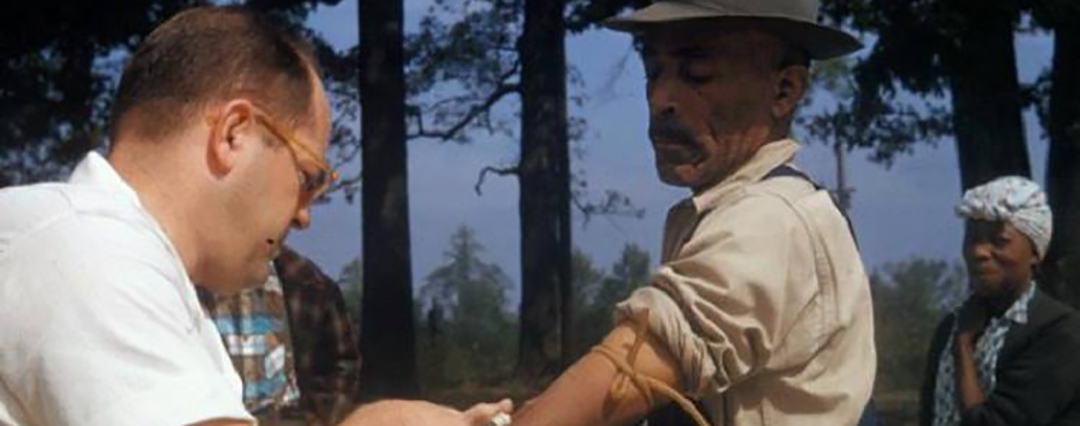On July 25, 1972, the year I was born, the Washington Star ran a story that they were tipped off from a whistleblower named Peter Buxtun, a venereal-disease investigator in San Francisco, about a research experiment being controlled by the Center for Disease Control (CDC) in conjunction with the Tuskegee Institute (now known as Tuskegee University), a historical black college in Alabama.
Six years earlier in 1966, Peter Buxtun filed an official protest of the experiment on ethical grounds but it was flatly rejected because the experiment hadn’t concluded yet. He was told that the study would continue until all of the test subjects had died and had been properly autopsied.
The day after the story broke in the Washington Star it was front page news in the New York Times.
It never ceases to amaze me how quickly people respond once the press gets ahold of a story.
What the CDC had been doing, working in conjunction with the Tuskegee Institute, was deliberately giving black men syphilis so that the United States federal government could study the natural progression and long term effects of syphilis if left untreated.
The test subjects, all poor black sharecroppers living in rural Alabama, had been told that they were receiving free health care from the U.S. government. They had no idea they had been given syphilis.
Initially the plan was to follow untreated syphilis in a group of black men for only 6 to 9 months and then transition to the second phase of the study which was to give them treatment. Somewhere along the way the federal government decided to forego the treatment part of the experiment and just study the long term effects of untreated syphilis. Like I said, these men were never to be told, at any point, that they had been given syphilis.
All in all a total of 600 men were used in the experiment. Of those 600, 399 of them had contracted syphilis before the study but 201 had not. In exchange for participating in the study they were promised free medical care, meals, and free burial insurance. When they complained of symptoms associated with syphilis all they were told was that they had “bad blood”.
By 1947 doctors already knew that penicillin was an effective cure for syphilis but they never gave any of these men penicillin because the purpose of the experiment was to see what the disease did to the body if left untreated. Not only did the men running this experiment not give them lifesaving treatment, they purposely withheld information about penicillin from the test subjects and even went as far as to prevent them from receiving penicillin treatments from other facilities in the area.
The ramifications from this experiment extended beyond the men inflicted. Among the lives that were claimed by this experiment were 40 wives of the men who participated and 19 children who had been born with congenital syphilis.
The offer of free medical care was a way of getting them to rely on the doctors who were conducting the study for medical treatment instead of going to someone outside of the study who might easily diagnose their symptoms as syphilis and treat it with penicillin, which as I said, was known as an effective treatment.
When the CDC suspected that Buxtun wasn’t satisfied with their answer to continue with the study until all 600 men were dead and their bodies properly autopsied they proactively sought and gained support for the study from chapters of the National Medical Association which represents black American physicians as well as the American Medical Association.
I guess their logic was that somehow this wasn’t as bad if Black people were okay with it too?
You hear people mention the Tuskegee Experiment but what you rarely hear acknowledged is that the entire experiment was conducted with the full participation and awareness of what was going on from black medical physicians.
Then President of Tuskegee Institute, Dr. Robert Russa Moton, and Dr. Eugene Dibble who was the head of John Andrews Hospital, both black men, endorsed the experiment and Registered Nurse Eunice Rivers, a black woman, who had been trained at Tuskegee and worked at John Andrews hospital, actively recruited the men to participate in the study.
She was the black face that ventured into rural Alabama to recruit these men into this study. She was the black face that these sharecroppers trusted who told them that this was all safe.
What is amazing to me is that this experiment could go on for 34 years without anyone being disturbed enough to file a complaint or go to the press.
To this day the Tuskegee Syphilis Study is cited as “arguably the most infamous biomedical research study in U.S. history”. It is because of the Tuskegee Experiment that today, whenever an American participates in a medical study, they are required to sign an informed consent agreement.

